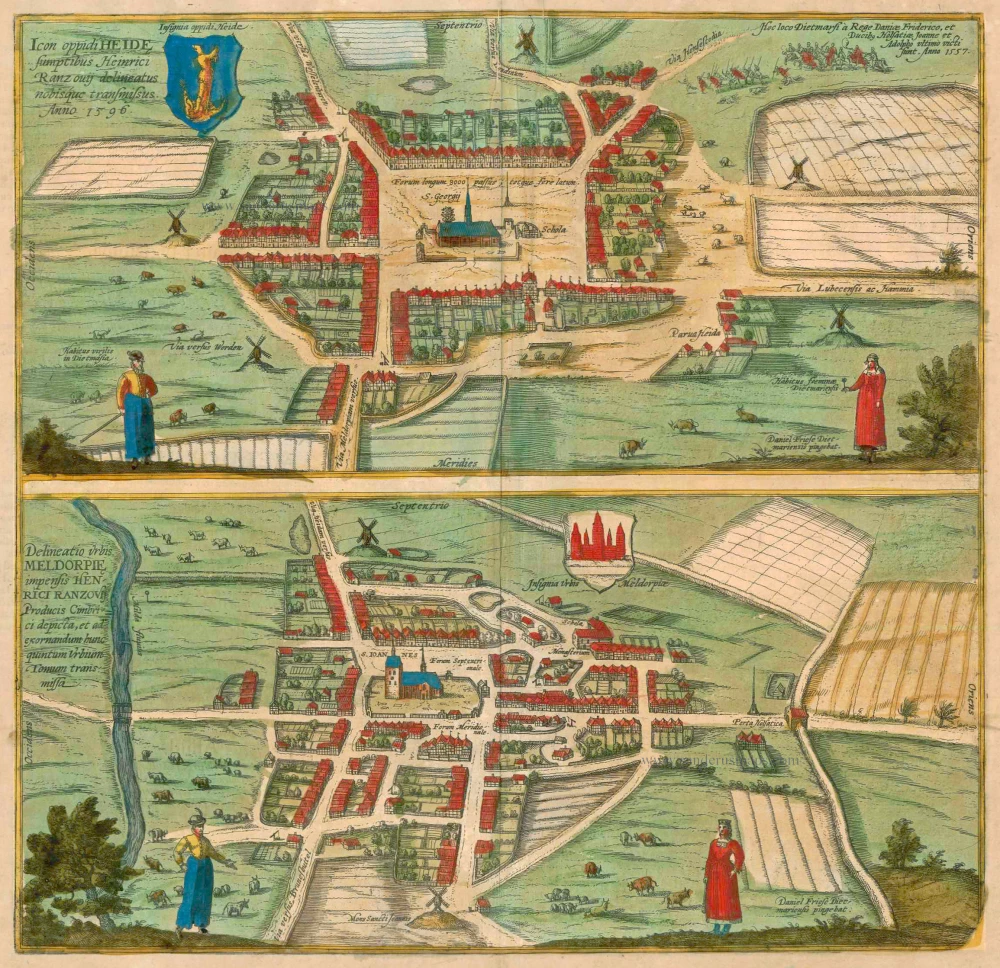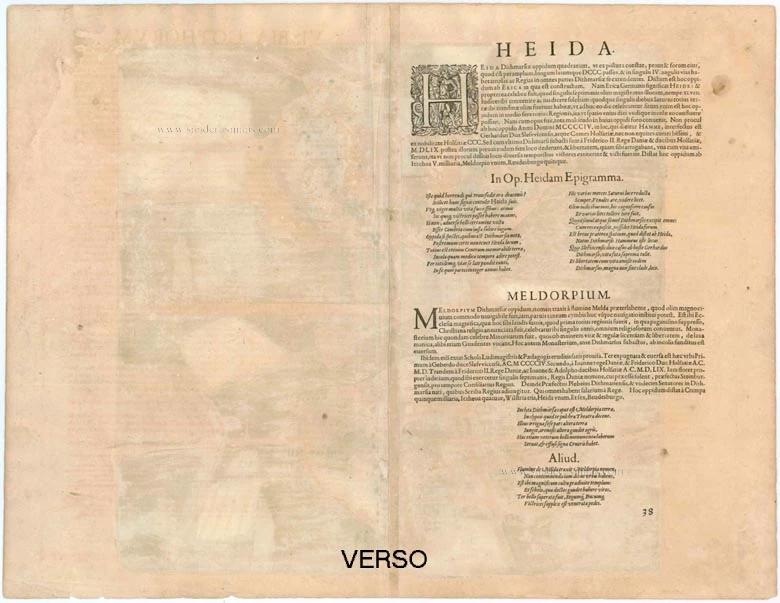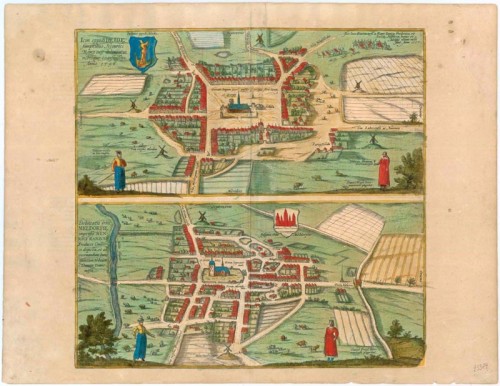Heide & Meldorf by Georg Braun & Frans Hogenberg. 1623
HEIDE
TRANSLATION OF CAPTION: Picture of the town of Heide, drawn at the expense of Heinrich Rantzau and conveyed to us in the year 1596.
Signed bottom right: Drawn by Daniel Freese of Dithmarschen.
COMMENTARY BY BRAUN: "Heide is a square town in Dithmarschen and the market there is also square, and according to the dimensions of the drawing very large, 8,000 paces long and wide, and more streets lead off from all four corners. The town takes its name from the heath [German Heide] on which it was built and became famous for the tribunal of 48 judges that used to assemble there every week to dispense justice. People from the whole area also came to market here every Saturday, as is still the case today."
The town of Heide is presented in a bird's-eye view from the south. The houses are arranged around the rectangular marketplace, whose middle stands St George's church, founded in 1560. Heide is first mentioned in records in 1404 as Uppe de Heyde. After 1447, when the inhabitants of the Dithmarschen region chose it as their place of assembly, it rose in importance. It remained the capital of the independent peasant republic of Dithmarschen until 1559. Its assemblies were held on the market square, which at 12 acres remains Germany's largest open marketplace. Heide is today the district capital of Dithmarschen and currently has some 21,000 inhabitants.
MELDORF
TRANSLATION OF CAPTION: Picture of the town of Meldorf, drawn at the expense of Heinrich Rantzau, lord of the Lower Elbe, and conveyed to us for the embellishment of this 5th volume.
Signed bottom right: Drawn by Daniel Freese of Dithmarschen.
COMMENTARY BY BRAUN: "Meldorf is also a small town in Dithmarschen; it takes its name from the River Melda flowing past, which was formerly navigable by boat and was of great advantage for the inhabitants. There is a magnificent church here, of which it is said that it was the first in the whole land when after the eradication of heathen idolatry the Christian faith was proclaimed for the first time."
In this bird's-eye view from the south, the houses are again grouped around the church at the centre of the town. Dedicated to St John but commonly known as Meldorf cathedral, the first church was constructed from AD 810 to 826; in the 13th century, it was rebuilt in the Gothic style. It originally stood right beside the North Sea, but due to land reclamation, now lies - like the town itself - some 6 km from the coast. Meldorf was first mentioned in records in 1076. It was chartered in 1265 and served as Dithmarschen's place of the assembly until Heide took over this role. Meldorf subsequently lost its charter in 1598. The town today has some 8,000 inhabitants. (Taschen).
Braun G. & Hogenberg F. and the Civitates Orbis Terrarum.
The Civitates Orbis Terrarum, also known as the 'Braun & Hogenberg', is a six-volume town atlas and the most excellent book of town views and plans ever published: 363 engravings, sometimes beautifully coloured. It was one of the best-selling works in the last quarter of the 16th century. Georg Braun, a skilled writer, wrote the text accompanying the plans and views on the verso. Many plates were engraved after the original drawings of a professional artist, Joris Hoefnagel (1542-1600). The first volume was published in Latin in 1572 and the sixth in 1617. Frans Hogenberg, a talented engraver, created the tables for volumes I through IV, and Simon van den Neuwel made those for volumes V and VI. Other contributors were cartographers Daniel Freese and Heinrich Rantzau, who provided valuable geographical information. Works by Jacob van Deventer, Sebastian Münster, and Johannes Stumpf were also used as references. Translations appeared in German and French, making the atlas accessible to a broader audience.
Since its original publication of volume 1 in 1572, the Civitates Orbis Terrarum has left an indelible mark on the history of cartography. Seven more editions followed the first volume in 1575, 1577, 1582, 1588, 1593, 1599, and 1612. Vol.2, initially released in 1575, saw subsequent editions in 1597 and 1612. The subsequent volumes, each a treasure trove of historical insights, graced the world in 1581, 1588, 1593, 1599, and 1606. The German translation of the first volume, a testament to its widespread appeal, debuted in 1574, followed by the French edition in 1575.
Several printers were involved: Theodor Graminaeus, Heinrich von Aich, Gottfried von Kempen, Johannis Sinniger, Bertram Buchholtz, and Peter von Brachel, all of whom worked in Cologne.
Georg Braun (1541-1622)
Georg Braun, the author of the text accompanying the plans and views in the Civitates Orbis Terrarum, was born in Cologne in 1541. After his studies in Cologne, he entered the Jesuit Order as a novice, indicating his commitment to learning and intellectual pursuits. In 1561, he obtained his bachelor's degree; in 1562, he received his Magister Artium, further demonstrating his academic achievements. Although he left the Jesuit Order, he continued his studies in theology, gaining a licentiate in theology. His theological background likely influenced the content and tone of the text in the Civitates Orbis Terrarum, adding a unique perspective to the work.
Frans Hogenberg (1535-1590)
Frans Hogenberg was a Flemish and German painter, engraver, and mapmaker. He was born in Mechelen as the son of Nicolaas Hogenberg.
By the end of the 1560s, Frans Hogenberg was employed upon Abraham Ortelius's Theatrum Orbis Terrarum, published in 1570; he is named an engraver of numerous maps. In 1568, he was banned from Antwerp by the Duke of Alva and travelled to London, where he stayed a few years before emigrating to Cologne. He immediately embarked on his two most important works, the Civitates, published in 1572 and the Geschichtsblätter, which appeared in several series from 1569 until about 1587.
Thanks to large-scale projects like the Geschichtsblätter and the Civitates, Hogenberg's social circumstances improved with each passing year. He died as a wealthy man in Cologne in 1590.
Icon Oppidi Heide [on sheet with] Delineatio Urbis Meldorpie.
Item Number: 23379 Authenticity Guarantee
Category: Antique maps > Europe > Germany - Cities
Old antique map with two bird’s-eye view plans by Georg Braun & Frans Hogenberg: Heide and Meldorf.
Title: Icon Oppidi Heide. [on sheet with] Delineatio Urbis Meldorpie.
Icon oppodi Heide sumptibus Heinrici Ranz ouij delineatus nobisque transmissus.
Anno 1596.
Daniel Friese Dietmariensis pingebat.
Delineatio Urbis Meldorphie impensis Henrici Ranzovij
Producis Cimbrici depicta, et ad exornandum hunc quitum Transmissa.
Daniel Friese Dietmariensis pingebat.
Cartographer: Daniel Friese & Heinrich Rantzau.
Date of the first edition: 1596.
Date of this map: 1623.
Date on map: 1596.
Copper engraving, printed on paper.
Map size: 368 x 382mm (14.49 x 15.04 inches).
Sheet size: 410 x 535mm (16.14 x 21.06 inches).
Verso: Latin text.
Condition: Excellent, superb old colour.
Condition Rating: A+.
References: Van der Krogt 4, #1742; Taschen, Br. Hog., p.387; Fauser, #5544 & #8681
From: Urbium Praeipuarum Mundi Theatrum Quintum Auctore Georgio Braunio Agrippinate. Part 5. Köln, Petrus von Brachel, 1623. (Van der Krogt 4, 41:1.5)
HEIDE
TRANSLATION OF CAPTION: Picture of the town of Heide, drawn at the expense of Heinrich Rantzau and conveyed to us in the year 1596.
Signed bottom right: Drawn by Daniel Freese of Dithmarschen.
COMMENTARY BY BRAUN: "Heide is a square town in Dithmarschen and the market there is also square, and according to the dimensions of the drawing very large, 8,000 paces long and wide, and more streets lead off from all four corners. The town takes its name from the heath [German Heide] on which it was built and became famous for the tribunal of 48 judges that used to assemble there every week to dispense justice. People from the whole area also came to market here every Saturday, as is still the case today."
The town of Heide is presented in a bird's-eye view from the south. The houses are arranged around the rectangular marketplace, whose middle stands St George's church, founded in 1560. Heide is first mentioned in records in 1404 as Uppe de Heyde. After 1447, when the inhabitants of the Dithmarschen region chose it as their place of assembly, it rose in importance. It remained the capital of the independent peasant republic of Dithmarschen until 1559. Its assemblies were held on the market square, which at 12 acres remains Germany's largest open marketplace. Heide is today the district capital of Dithmarschen and currently has some 21,000 inhabitants.
MELDORF
TRANSLATION OF CAPTION: Picture of the town of Meldorf, drawn at the expense of Heinrich Rantzau, lord of the Lower Elbe, and conveyed to us for the embellishment of this 5th volume.
Signed bottom right: Drawn by Daniel Freese of Dithmarschen.
COMMENTARY BY BRAUN: "Meldorf is also a small town in Dithmarschen; it takes its name from the River Melda flowing past, which was formerly navigable by boat and was of great advantage for the inhabitants. There is a magnificent church here, of which it is said that it was the first in the whole land when after the eradication of heathen idolatry the Christian faith was proclaimed for the first time."
In this bird's-eye view from the south, the houses are again grouped around the church at the centre of the town. Dedicated to St John but commonly known as Meldorf cathedral, the first church was constructed from AD 810 to 826; in the 13th century, it was rebuilt in the Gothic style. It originally stood right beside the North Sea, but due to land reclamation, now lies - like the town itself - some 6 km from the coast. Meldorf was first mentioned in records in 1076. It was chartered in 1265 and served as Dithmarschen's place of the assembly until Heide took over this role. Meldorf subsequently lost its charter in 1598. The town today has some 8,000 inhabitants. (Taschen).
Braun G. & Hogenberg F. and the Civitates Orbis Terrarum.
The Civitates Orbis Terrarum, also known as the 'Braun & Hogenberg', is a six-volume town atlas and the most excellent book of town views and plans ever published: 363 engravings, sometimes beautifully coloured. It was one of the best-selling works in the last quarter of the 16th century. Georg Braun, a skilled writer, wrote the text accompanying the plans and views on the verso. Many plates were engraved after the original drawings of a professional artist, Joris Hoefnagel (1542-1600). The first volume was published in Latin in 1572 and the sixth in 1617. Frans Hogenberg, a talented engraver, created the tables for volumes I through IV, and Simon van den Neuwel made those for volumes V and VI. Other contributors were cartographers Daniel Freese and Heinrich Rantzau, who provided valuable geographical information. Works by Jacob van Deventer, Sebastian Münster, and Johannes Stumpf were also used as references. Translations appeared in German and French, making the atlas accessible to a broader audience.
Since its original publication of volume 1 in 1572, the Civitates Orbis Terrarum has left an indelible mark on the history of cartography. Seven more editions followed the first volume in 1575, 1577, 1582, 1588, 1593, 1599, and 1612. Vol.2, initially released in 1575, saw subsequent editions in 1597 and 1612. The subsequent volumes, each a treasure trove of historical insights, graced the world in 1581, 1588, 1593, 1599, and 1606. The German translation of the first volume, a testament to its widespread appeal, debuted in 1574, followed by the French edition in 1575.
Several printers were involved: Theodor Graminaeus, Heinrich von Aich, Gottfried von Kempen, Johannis Sinniger, Bertram Buchholtz, and Peter von Brachel, all of whom worked in Cologne.
Georg Braun (1541-1622)
Georg Braun, the author of the text accompanying the plans and views in the Civitates Orbis Terrarum, was born in Cologne in 1541. After his studies in Cologne, he entered the Jesuit Order as a novice, indicating his commitment to learning and intellectual pursuits. In 1561, he obtained his bachelor's degree; in 1562, he received his Magister Artium, further demonstrating his academic achievements. Although he left the Jesuit Order, he continued his studies in theology, gaining a licentiate in theology. His theological background likely influenced the content and tone of the text in the Civitates Orbis Terrarum, adding a unique perspective to the work.
Frans Hogenberg (1535-1590)
Frans Hogenberg was a Flemish and German painter, engraver, and mapmaker. He was born in Mechelen as the son of Nicolaas Hogenberg.
By the end of the 1560s, Frans Hogenberg was employed upon Abraham Ortelius's Theatrum Orbis Terrarum, published in 1570; he is named an engraver of numerous maps. In 1568, he was banned from Antwerp by the Duke of Alva and travelled to London, where he stayed a few years before emigrating to Cologne. He immediately embarked on his two most important works, the Civitates, published in 1572 and the Geschichtsblätter, which appeared in several series from 1569 until about 1587.
Thanks to large-scale projects like the Geschichtsblätter and the Civitates, Hogenberg's social circumstances improved with each passing year. He died as a wealthy man in Cologne in 1590.






